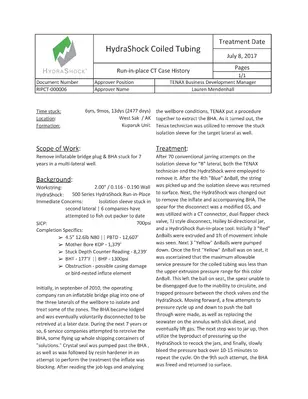
The initial treatment ended with disconnecting from the inflatable bridge plug and associated BHA. The operator attempted to fish the entire BHA 6 times over the next 7 years, even bringing up highly experienced personnel from different parts of the US.
The initial procedure called for pulling the isolation and diverter sleeves to allow for the largest bore size. This is due to the OD of the stuck BHA being larger than the ID of the diverter sleeve. The problem this posed is being able to properly locate and drop into the appropriate lateral, and mores locating the BHA. The HydraShock was first utilized to free the isolation sleeve for the “B” lateral, as the first company utilized to remove it jarred 70 times to no avail. It took 4 ∆nBalls and a single jar hit to remove the isolation sleeve. A 3.0 GS Spear with an extended reach was utilized to fish the BHA, due to the design of the disconnect. Next the “B” lateral was accessed and the fish engaged.
On the second “Red” ∆nBall, 16,000lbs was gained back, and the CT moved down 1.3ft. The first “Yellow” ∆nBall seated, but the upper range for the maximum allowable service pressure for the coiled tubing was reached before it extruded. Due to the multiple laterals, 3 different types of treatment fluids (Slick Diesel, Seawater, lift gas), it was theorized that the extrusion pressures might have a variance, especially with different annular fluid movements. Once engaged, the GS spear cannot be disengaged without circulating, which posed a problem with a ∆nBall on seat. So by pressuring up on the HydraShock, the Hailey jars were cocked, and a 10-15 minute slow bleed utilized to bleed the pressure from the BHA barely keeping the DFCVs open.
This method of floating the DFCVs to alleviate BHA pressure allowed us to utilize the jars in an extended lateral where jars were not able to be cocked in previous runs. On the 9th jar hit and HydraShock pressure cycle the BHA freed and returned to surface. The pressure between the checks and the seated HydraShock ∆nBall was 1,268psi when tested upon returning to the facility in Deadhorse.
This unique set of circumstances displayed both the versatility of the HydraShock as a solution to stuck “anything” as well as the experience of the personnel on location to pivot within the safety constraints to solve problems.





